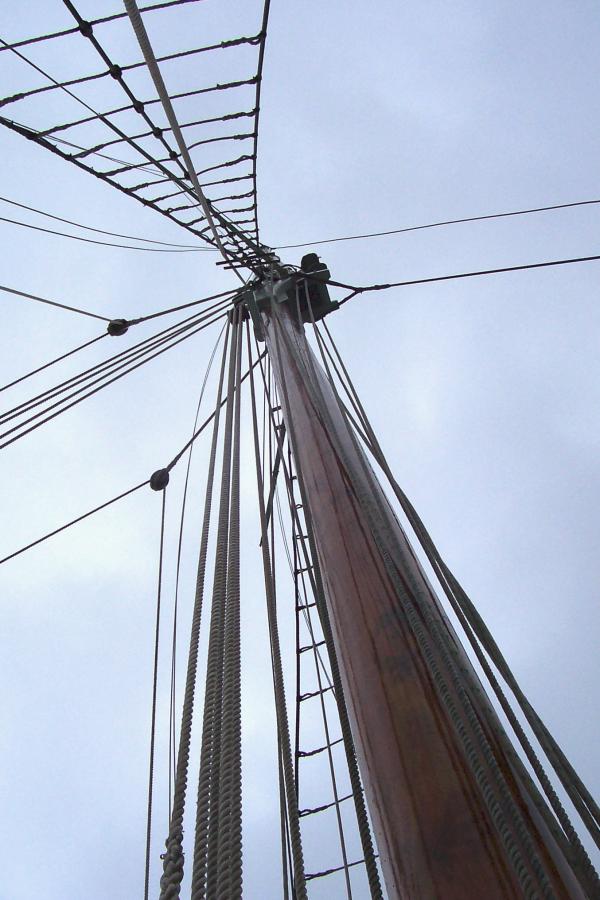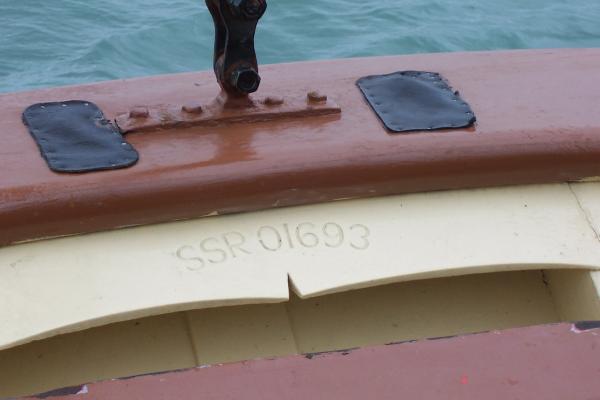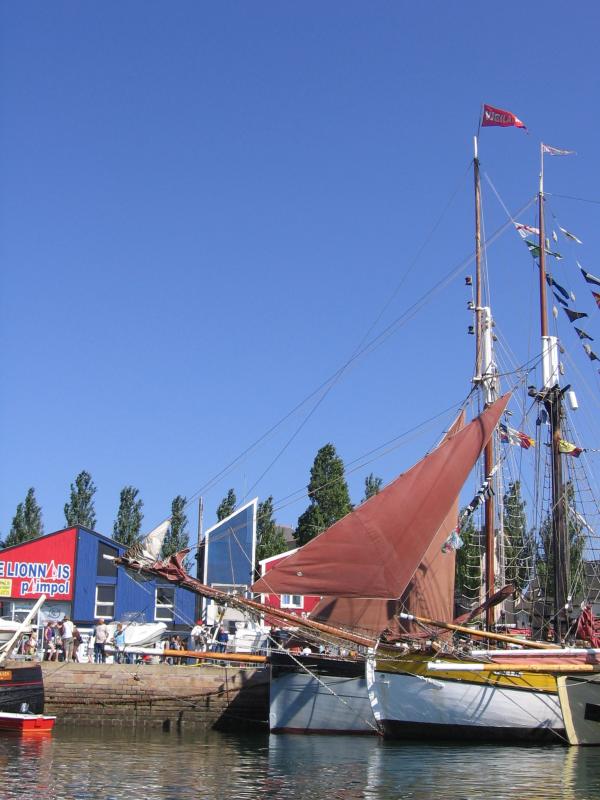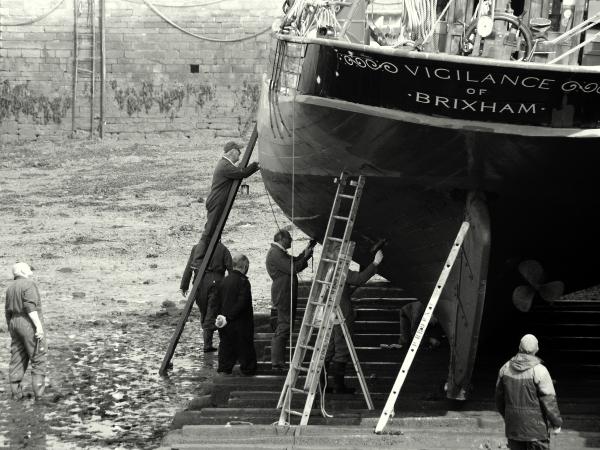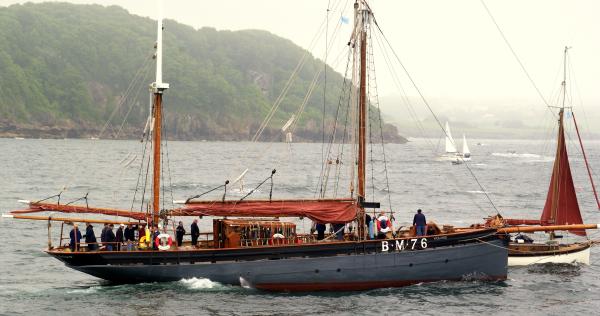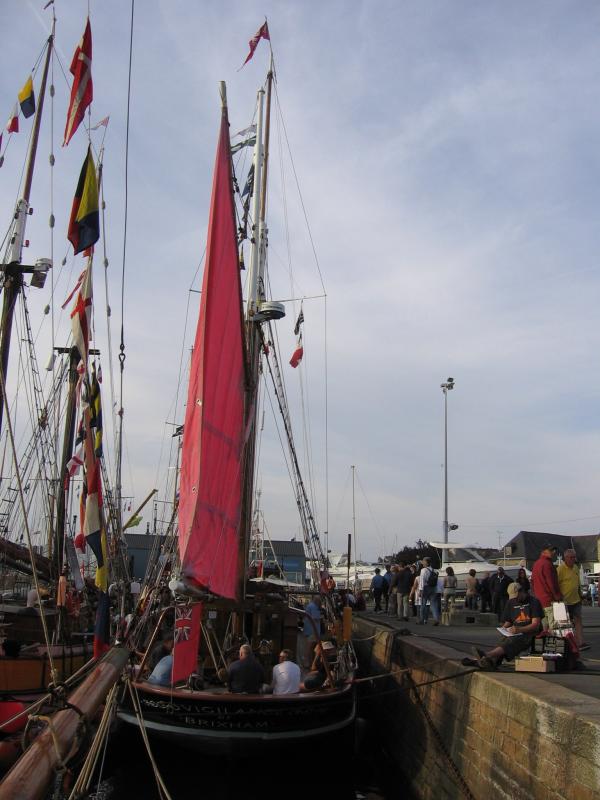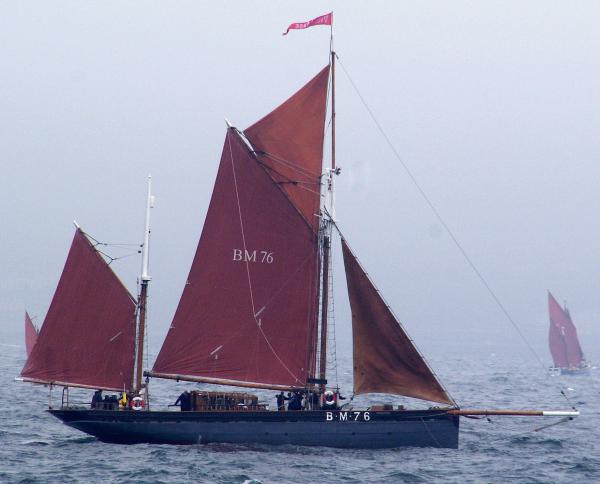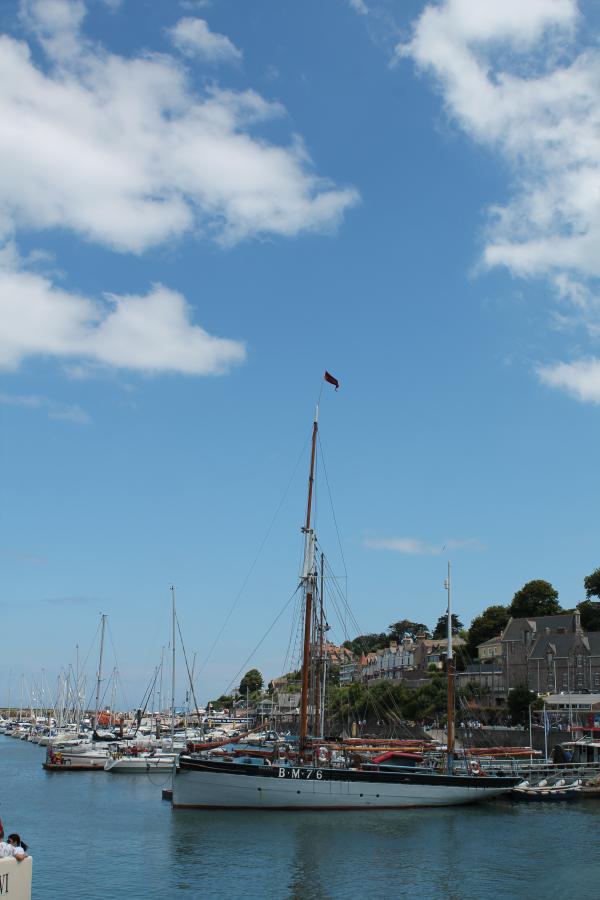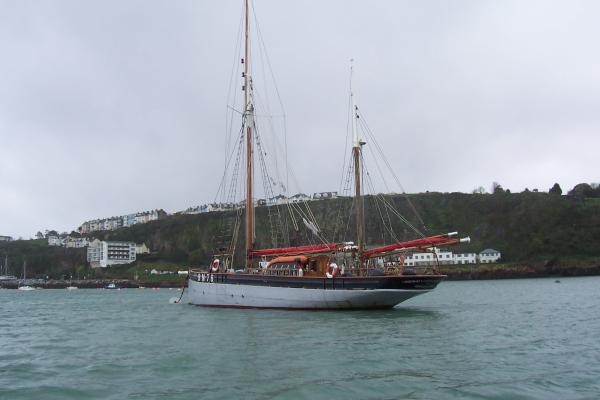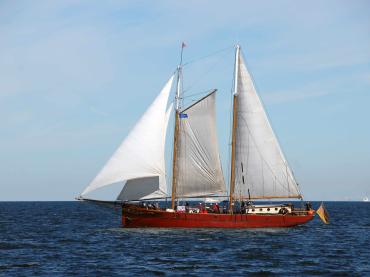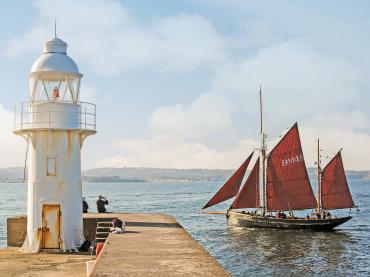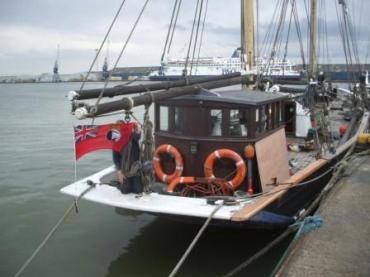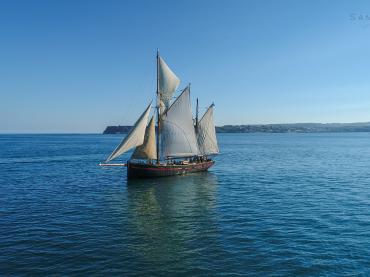

Details
Construction
Dimensions
History
Built in 1926 by JW & A Upham, of Brixham, for George Foster and skippered by his brother Fred, both from Brixham, VIGILANCE was launched in December of that year by George Foster’s grand-daughter Alice Friend. The vessel’s £1000 cost was paid in full to Upham’s on her launch day. She had oak frames, 2 ½ inch oak topside planking, 3in oak planking at the bilges, and 2in elm planking below the waterline.
VIGILANCE was a typical ketch-rigged trawler, designed by Upham’s, with a graceful counter stern, long run and skeg at the heel of her keel. In 1933 she won the Brixham Regatta’s King George V Perpetual Cup (the ‘King’s Cup’) in a fresh breeze, despite being last of the seven ketches over the start line. In lighter airs she was less successful. Registered with the number BM 76, VIGILANCE was fished by the Foster brothers until 1937 when the fall in fish landings and the loss of uninsured gear forced them out of business. In December of that year Upham’s yard bought her back for £525 but did not use her for fishing. In February 1938, lying idle on a mooring in the outer harbour, she was badly damaged when she was swept off it by a storm from the NNW and sustained extensive damage to her port side when she drove onto Torbay Lass. She was taken into the inner harbour for repairs.
It is believed that she was used as a naval kite balloon mooring vessel during the Second World War. After the war she was converted into a yacht and was fitted with a paraffin engine. She was sold in January 1949 to William Meldrum and re-sold two months later to Harold Owen who sailed her at Shoreham. However, Owen was drowned when he fell from his other boat in 1952 and VIGILANCE was set on fire on the same day as his cremation; the cause of the fire has never been established, though locals thought that his wife had torched her in an effort to stop their son going to sea. As a hulk, she served as a pontoon and storeroom at Shoreham until being bought in 1955 by an Australian who jury rigged her with a tarpaulin and attempted to sail her away. She was deemed a hazard to shipping and towed into Littlehampton by the coastguard.
Later in 1955 the Australian sold her to Ken Harris, a carpenter and cabinet maker, who began a singlehanded rebuild of VIGILANCE which took him until 1971. Most of the frames were renewed in 10” x 5” oak, and the topsides replanked (with mahogany and Malayan keruin) upwards from seven strakes above the keel. Where new planks were necessary below the waterline they were of larch. Deck beams, deck, deck house, skylights and bitts were new and Ken Harris handmade 1.5 tons of iron fastenings. The lower sections of both masts had been destroyed in the fire and so a landing light post from an aerodrome was acquired and scarfed to make new sections. An extra twelve berths were added to her accommodation so that she could be used for charters.
From 1971 to 1978 she was based at Cowes and with the registration number TS K332 started chartering. In 1978 Harris moved VIGILANCE to Dartmouth, and in 1983, after sailing the boat for twelve years, he added an extra keel, of greenheart, to strengthen her and improve her sailing performance to windward. An all woman crew sailed VIGILANCE in the 1983 Tall Ships Race and, in 1986, after moving her base to north Wales, she carried a school expedition to Norway’s Lofoten Islands, 200 miles north of the Arctic Circle. Prior to that trip her Leyland-made Matilda tank engine was replaced by a 260 hp Scania diesel.
In 1994 VIGILANCE moved again, this time to Peel Harbour in the Isle of Man. It was from there in 1997 that the boat was purchased from Harris for £60,000 by a syndicate and returned to her home port. She was refitted and restored by Philip & Son on the Dart, when 22 planks were replaced in her hull and she was fitted with modern navigational equipment.
In 1999 she collided with LEADER in the Brixham Regatta race and needed a new bowsprit. In the winter of 2003/4 a new engine was fitted and in each successive winter repairs and restoration have been carried out to her hull, spars and rigging. The mainmast was replaced in 2004, main boom in 2007 and mizzen boom in 2008. New main and mizzen sails were bent in 2007. In winter 2010/11 new shrouds were fitted.
She has twelve passenger and four crew berths. Her sail inventory includes mainsail, summer and winter topsails, mizzen and mizzen topsail, stay foresail, mizzen staysail, storm jib and three other jibs of different weights.
Source: Historic Sail, Britain's surviving working craft, Paul Brown, the History Press.
Starting from October 2022, VIGILANCE has been at Stirling & Sons yard, Plymouth for restoration work. On 8th April, following sea trials, VIGILANCE returned home to Brixham.
Significance
1. What is the vessel’s ability to demonstrate history in her physical fabric?
Evidence for designs, functions, techniques, processes, styles, customs and habits or uses and associations in relation to events and people. How early, intact or rare these features are may impact on significance.
As with all vessels of her type, Vigilance’s design was subtly different as she was a one-off order. The most significant variation is the absence of transom stern, with her elliptical counter based on those of the larger Brixham fruit schooners built in the same yard. Most of her frames are original, as is her aft cabin (used as the crew’s living accommodation) which includes the bunks, panelling, lockers, horn timbers and frames in the way of the mizzen mast. All of the keel from forefoot through to rudder skeg is original and was encapsulated in a steel box in 1998 to give the vessel a strengthened “spine”. The masts, bowsprit and sail plan are also original according to the drawings of Vigilance’s sister ship Valerian, built at the same yard in 1923. Other early features include: guides and rails, the ship’s bell, the capstan, compass, derrick (used as a crane to haul catch on deck), the rudder, hatches and leg joints. Her hull form remains as built, with the exception of a drop in the sheer of the counter stern that has developed over time and is due to be addressed as part of future conservation work.
Vigilance has undergone a variety of uses since ceasing fishing in the 1930s which have been reflected in her fabric. A ‘doghouse’ has been fitted on deck, a rigid framed ‘cradle’ now houses the mainsail boom, a steering wheel has replaced the original tiller and internally a galley, living area, bunks and heads have been fitted in what was previously the fish hold. A steam winch was added early in her working life which is now powered by a generator. A nominal petrol/paraffin auxiliary wing engine was installed in the 1950s. Conservation work was carried out during the 1950s-60s which included renewal of some frames in oak and the topsides were re-planked (with mahogany and Malayan keruin) upwards from seven strakes above the keel. Where new planks were necessary below the waterline these were of larch. The lower sections of both masts were destroyed by fire in the 1950s and a landing light post from an aerodrome was acquired and scarfed to make new sections. In 2015, further repairs were carried out to the starboard side using like-for-like materials.
2. What are the vessel’s associational links for which there is no physical evidence?
Associations with people or places. Off-ship research.
Vigilance has strong local connections to Brixham and the Torbay area, being the last Brixham sailing trawler launched from Upham’s Yard, and she still retains links today with descendants of the families which built and owned her. During her fishing career, she was noted for winning the King George VI Cup twice which was a considerable achievement. In the Second World War, Vigilance was requisitioned by the Admiralty and used as a barrage balloon- mooring vessel in the outer harbour at Brixham in order to protect naval shipping and those preparing the D Day invasion fleet from enemy aerial attack. Vigilance’s history has been well researched and is documented in a publication printed in 2010. Log books, crew lists, newspaper articles, registration documents and photographs all survive and comprise her archive. She has been featured in a number of short films and television programmes and her story is also covered in a special documentary produced by Brixham Community College. Vigilance is supported today by a group of 80 volunteers and is a recognised part of the tourism industry within the town. She has been recorded on the National Register of Historic Vessels since 2013 and is a member of the National Historic Fleet, being a rare survivor of her type and an example of the evolution of Brixham trawler design.
3. How does the vessel’s shape or form combine and contribute to her function?
Overall aesthetic impact of the vessel, her lines, material she was built from and her setting. Does she remain in her working environment?
Vigilance’s sleek lines and tall gaff rigged sails are aesthetically pleasing and reflect a design which stems from the 18th Century, when those seeking a solution to limited fish stocks created a form of vessel suited to deep sea trawling. Her elliptical counter stern is now the only one left of its kind and gave her better buoyancy aft, thus reducing the probability of being pooped by a following sea. Her long run and skeg at the heel of her keel were designed for power and speed. Like all Brixham trawlers of this type, her hull is massively constructed to allow for carrying a heavy wooden beam trawl, some 45 feet long with trawl net and gear attached, 2-3 tons weight, along the sea bed, at 2-3 knots. Her large sail area, about 2500 sq feet, was necessary to achieve this speed and her deep draught and wide beamed hull provided a steady work platform in order to be able to trawl in boisterous seas, gale force winds and, furthermore, be fast enough to reach the markets with the catch in prime condition. Vigilance continues to operate from the Heritage Pontoon in Brixham, only feet away from the site of Upham’s Yard where she was built.
Source: NHS-UK team, 19 February 2019.
Key dates
-
1926
Built by J. W. Upham of Brixham
-
1949
Converted to a yacht
-
1950s
Badly damaged by fire and rebuilt over 15 years
-
1997
Bought by a group dedicated to restoration
-
2024
Restoration work in Plymouth
Grants
-
August 2022
Vigilance has been awarded an £820,000k grant from the National Heritage Memorial Fund, for vital below the waterline repairs.
-
August 2022
A £2000 grant towards the ongoing restoration was awarded from the Royal Warrant Holders Charity Fund.
-
2007/2008
A Sustainability Award of £3,000 towards the cost of new sails was made from the Strategic Development Fund of National Historic Ships
-
2000/01
The Heritage Lottery Fund awarded £520 for maintenance work
Sources
Langley, E & Small, M, Lost Ships of the West Country, Stanford Maritime, 1988
Old Gaffer's Association Member's Handbook and Boat Archive, 1993
Classic Boat: Looking after Vigilance, September 1999
Classic Boat: The Carrick Craic, September 1995
Classic Boat: Charter UK Destinations - Wish you were here?, February 2011
Classic Boat: T boned at Brixham, August 1999
Classic Boat: Brixham sailing trawler Vigilance wins King's Cup again, August 2004
Classic Boat: At Close Quarters Ken Harris: the man of vigilance, September 1999
Own this vessel?
If you are the owner of this vessel and would like to provide more details or updated information, please contact info@nationalhistoricships.org.uk

